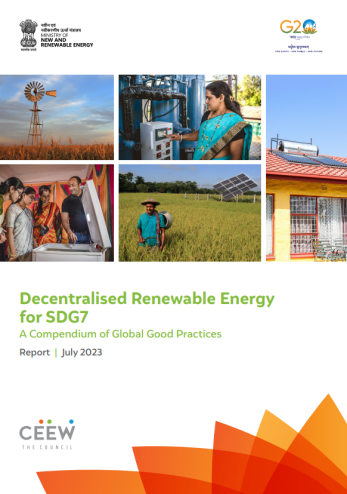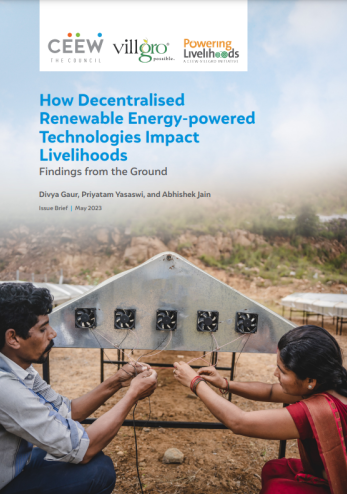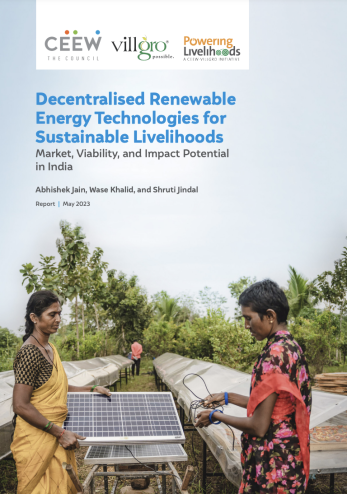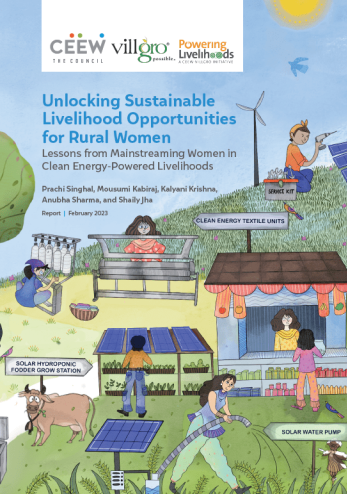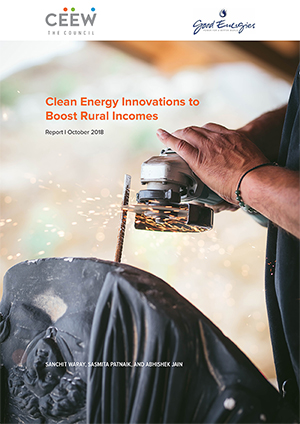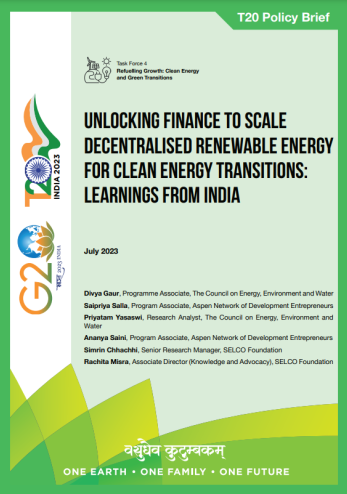Report
Clean Energy Innovations to Boost Rural Incomes
Sanchit Waray, Sasmita Patnaik, Abhishek Jain
October 2018 | Sustainable Livelihoods
Suggested Citation: Waray, Sanchit, Sasmita Patnaik, and Abhishek Jain. 2018. Clean Energy Innovations to Boost Rural Incomes. New Delhi: Council on Energy, Environment and Water.
Overview
Ninety-two per cent of the electricity-deprived population of India lives in rural areas. Farm power availability is a third of that of China. More than four million rural micro-enterprises in India mention lack of reliable electricity as a major bottleneck to their business. Clean energy innovations for farm and non-farm micro-enterprises can bridge gaps in the centralised electricity supply system and power income-generating activities in rural areas. This study by the Council on Energy, Environment and Water, envisions to maximise the role of clean energy as a catalyst for increasing rural incomes.
In an interview with Power4All, Abhishek Jain, Senior Programme Lead, CEEW speaks about boosting rural incomes through innovation in distributed clean energy and the USD 50 billion market opportunity for new livelihood appliances.
Key Highlights
- Significant market opportunity exists in India’s rural economy for mechanisation through clean energy innovations. For instance, in farm sector, merely three activities – pesticide spraying, rice transplanting, and harvesting of grain crops – have a total market potential of about USD 40 billion.
- Beyond agriculture, clean energy innovations have a market potential of 13 billion USD, which could transform enterprises engaged in activities such as custom tailoring, food processing, poultry, and livestock rearing among others.
- We found merely 20 odd livelihood appliances, which can effectively run on decentralised renewable energy (DRE). These include innovations such as solar pumps, solar-powered milking machines, milk chillers, sewing machines, solar charkhas, cold storage, and knapsack sprayer. Their deployment is limited to a few hundreds, in comparison to millions of farmers and rural microenterprises in 600,000 villages of India.
- Energy efficiency is critical to make DRE-based livelihood applications economically viable. However, existing livelihood appliances prevalent in rural areas are not designed for efficiency, but for unreliable and subsidised/flat-priced electricity.
- The farm sector market is more difficult to capture than the non-farm due to low utilisation rates of agricultural equipment and the CAPEX-heavy nature of DRE solutions.
- Reduction in battery costs and development of cost-effective, super-efficient, small-sized motors could significantly improve the economic viability of DRE.
- The market for smaller livelihood solutions is significantly fragmented and cluster-based, potentially requiring hundreds of small and medium scale enterprises to capture the same.
- Customer awareness and financing are major barriers to adoption of clean energy solutions for livelihood applications.
Proportion of micro-enterprises reporting electricity access among the top two bottlenecks to their business
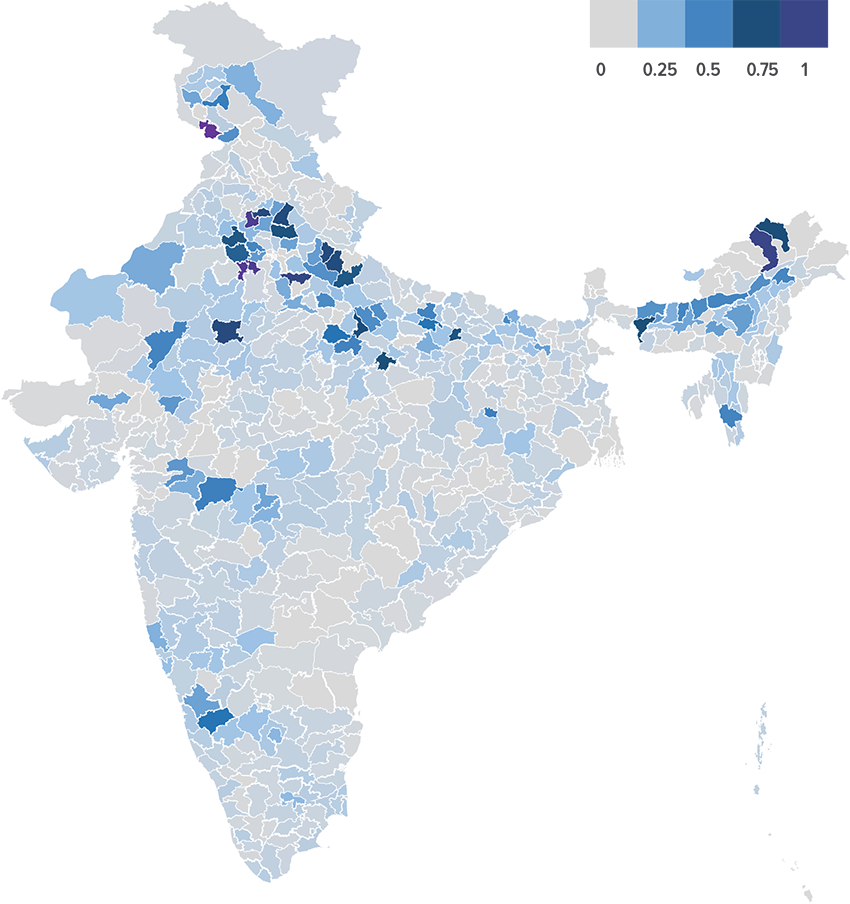
Source: Ministry of Statistics and Programme Implementation (2017) “Key Indicators of Unincorporated Nonagricultural Enterprises (Excluding Construction) in India, 2015-16.” New Delhi: Government of India.
https://gramener.com/indiamap/
Note: This map depicts districts with rural micro-enterprises reporting unreliable electricity among the top two bottlenecks to their business. The colors in the legend indicate the proportion of such enterprises in a particular district.
The significant market opportunity is impeded with major gaps in the entrepreneurial ecosystem to support development and deployment of clean energy innovations in livelihoods. Following are the challenges, categorised at each stage of the product’s life cycle.
Key gaps in the innovation ecosystem
Concept to prototype
- Lack of financial support: Given the high-risk nature of the product development process, there is a dire need for capital grants from philanthropic and public funds.
- Inadequate physical infrastructure: The pace of intervention is slowed due to limited access to fabrication labs and other such facilities where prototypes could be built and products could be tested.
- Lack of policy clarity: There is no clarity regarding the role of DRE along with the grid supply leading to business uncertainty for entrepreneurs. This affects the innovation ecosystem and the inflow of financial support for DRE-powered products.
- Limited cost incentives: Due to subsidised electricity rates in rural areas, the cost incentives for developing energy-efficient productive use appliances are limited. Improving energy efficiency of appliances will be critical to improving the economic viability of DRE-powered products.
Prototype to pilot
- Lack of adequate knowledge of valuation of technology: The process of technology valuation is not well-developed in government institutions, limiting technology transfer from public research institutions.
- Limited collaborations: Collaborations between larger businesses and smaller entrepreneurs has remained limited. Such collaborations at the right stage can lead to improvements in the design and efficiency of the product, and thus its commercial viability.
- Lack of business skills: Innovators may have the technical skills, but many may not be adept at skills such as marketing, strategy, or finance required to get the product off the ground.
Pilot to commercial product
- Limited access to affordable market research: Access to up-to-date market research information is critical for the development of DRE-powered appliances and machinery, but conducting such market research is an expensive exercise for early stage enterprises.
- High capital cost of DRE: The high capital cost of DRE is one of the biggest impediments to adoption by customers when compared to low capital cost of diesel-powered equipment.
- Aligning product designs with customer needs: Product demonstrations and processes to incorporate consumer feedback during the design phase are crucial to improve user acceptance.
Commercial product to large-scale deployment
- Low-utilisation rates: Given that DRE-powered products require high-capital investments, the utilisation rate of the asset is a key determinant of its economic viability.
- Low adoption of energy efficient appliances: Energy efficient livelihood appliances, owing to their high prices and low sales volumes, are not prioritised by distributors of durable products.
- Barriers to accessing loans: Lack of collateral on the part of the end consumer creates impediments to accessing loans, which limits the scale of adoption under a direct-purchase model.
A market opportunity of over USD 50 billion exists for clean energy innovations
powering livelihoods in rural India.





